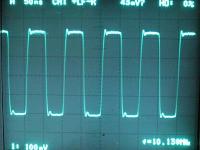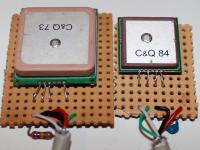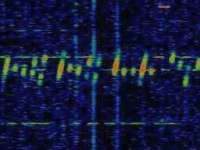 |
Huff Puff calibration The Huff Puff method of frequency calibration in the U3 was originally introduced to deal with the poor jitter performance of Sirf III chipset based GPS modules. However it is capable of improving calibration performance with any GPS module. The description applies to the U3 (AD9850 DDS with 125MHz reference oscillator) but is also applicable to the U3S (using Si5351A synthesiser, 27MHz reference oscillator). |
 |
Spectrum Analyser tests Here are some spectrum analyser testing results, showing harmonic levels, LPF performance, and power output of the U3 kit. The U3S will be slightly different but you can assume broadly similar results apply, particularly the LPF curves are the same. |
 |
DDS module testing [U3 only] Prior to the development of the Si5351A synthesiser module kit used in the U3S kit, the U3 kit used the pre-built AD9850 DDS module. All modules were tested and aligned prior to shipment. This page documents the procedure used, and may be useful if you need to re-align your DDS module for any reason. |
 |
GPS compatibility notes The Ultimate series of QRSS/WSPR kits are optionally able to use a GPS receiver for frequency calibration, time setting, location information, and timekeeping purposes. GPS modules vary and this page lists some common GPS modules known to work well with the kits, and any specific connection details required. |
 |
U3 Slow-Hell settings This page is about the configuration settings in the Ultimate3/3S for slow-Hellschreiber mode ("slow Hell"). It's a tricky topic and had caused some confusion. So this page attempts to explain the settings, their interpretation, and relation to each other. |
 |
U3S PA Bias study Dave G3WUN wrote with some observations about the bias setting in the U3S PA. By backing off the bias a little, the harmonic levels were significantly lower than when set for maximum power output. This experiment repeats Dave's work and extends it, across multiple bands and more analysis. |
 |
Bifilar/trifilar U3S PA Output Replacing L1 (25 turns FT37-43 toroid) with a bifilar output transformer (10 turns FT37-43 toroid) seems to significantly increase the power output. This article documents a set of measurements of power outputs using bifilar and trifilar output transformers. |
 |
High precision OCXO U3S by Pete ZL2IK Obtaining really excellent frequency stability results with a U3S and OCXO Synth requires attention to several details (proper OCXO adjustment, thermal considerations, power supplies). This article provides more information and Pete ZL2IK describes his U3S assembly and power regulation. |
 |
DT Investigation This is an investigation into the accuracy of the WSPR and JT65 timing in the U3S. The conclusion is that the timing is very closely compliant with the relevant protocols. |
U3/U3S Information
- Details
- Hits: 52786
